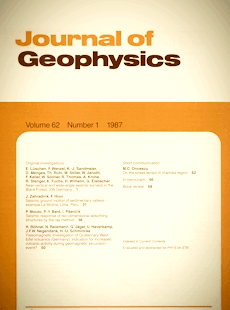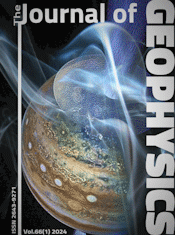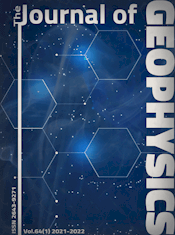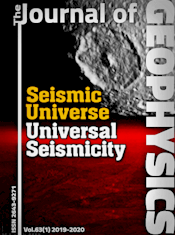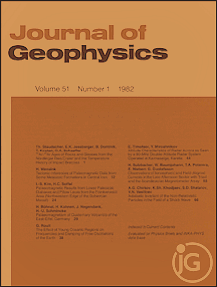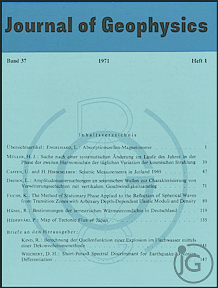On the stress tensor in Vrancea region
Article Sidebar
Published:
Nov 5, 1987
Keywords:
Stress tensor,
Vrancea region
Volumes
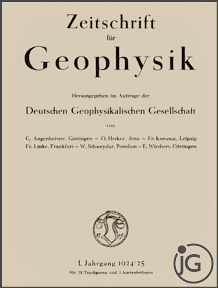
Vols. 1-18 (1924-1944), ISSN 0044-2801
Main Article Content
M.C. Oncescu
Centre of Earth Physics and Seismology, Bucharest Romania
Abstract
Presented is a new application of Gephart-Forsyth inverse technique for predicting directions and senses of slip. In Vrancea region, the compression axis is thus found to act in a NE-SW direction and not in a SE-NW direction, as is commonly thought from focal mechanism results. In addition, evidence is provided that the stresses in the crust are decoupled from those in the subducted slab.
 ARK: https://n2t.net/ark:/88439/y054021
ARK: https://n2t.net/ark:/88439/y054021
Permalink: https://geophysicsjournal.com/article/101
Article Details
How to Cite
Section
References
Bleahu, M.D., Boccaletti, M., Manetti, P., Peltz, S. (1973) Neogene Carpathian Arc: a continental arc displaying the features of an 'Island Arc'. J. Geophys. Res. 78:5025-5032
Constantinescu, L., Enescu, D. (1984) A tentative approach to possibly explaining the occurrence of the Vrancea earthquakes. Rev. Roum. Geol. Geophys. Geogr. Geophys. 28:19-32
Gephart, J.W. (1985) Principal stress directions and the ambiguity in fault plane identification from focal mechanisms. Bull. Seismol. Soc. Am. 75:621-625
Gephart, J.W., Forsyth, D.W. (1984) An improved method for determining the regional stress tensor using earthquake focal mechanism data: application to the San Fernando earthquake sequence. J. Geophys. Res. 89:9305-9320
Harmsen, S.C., Rogers, A.M. (1986) Inferences about the local stress field from focal mechanisms: application to earthquakes in the Southern Great Basin of Nevada. Bull. Seismol. Soc. Am. 76:1560-1572
McKenzie, D.P. (1969) The relation between fault plane solutions for earthquakes and the directions of principal stresses. Bull. Seismol. Soc. Am. 59:591-601
Muller, G., Bonjer, K.P., Stocki, H., Enescu, D. (1978) The Romanian earthquake of March 4, 1977. I Rupture process inferred from fault plane solution and multiple-event analysis. J. Geophys. 44:203-218
Oncescu, M.C. (1986) Relative seismic moment tensor determination for Vrancea intermediate depth earthquakes. Pure Appl. Geophys. 124:931-940
Oncescu, M.C., Apolozan, L. (1984) The earthquake sequence of Rimnicu Siirat, Romania, of 21-22 February 1983. Acta Geophys. Pol. 32:231-238
Oncescu, M.C., Apolozan, L. (1985) The seismic doublet from Vrancea region of August 1, 1985 (in Romanian). Stud. Cerc. Geol. Geofiz. Geogr. Geofiz. 24:12-16
Oncescu, M.C., Trifu, C.I. (1987a) A large seismic sequence on April 27-29, 1986 in Vrancea foredeep. Rev. Roum. Geol. Geophys. Geogr. Geophys. 31 (In press)
Oncescu, M.C., Trifu, C.I. (1987b) Depth variation of moment tensor principal axes in Vrancea (Romania) seismic region. Ann. Geophys. 58:149-154
Oncescu, M.C., Burlacu, V., Anghel, M., Smalberger, V. (1984) Threedimensional P-wave velocity image under the Carpathian Arc. Tectonophysics 106:305-319
Radu, C., Oncescu, M.C. (1980) Focal mechanism of Romanian earthquakes and their correlation with tectonics. I. Catalogue of fault plane solutions (in Romanian). Report CFPS/CSEN 30.78.1
Radu, C., Oncescu, M.C. (1982) A note on the deep Vrancea earthquake of May 16, 1982 (in Romanian). Report CFPS/CSEN 30.81.8
Radu, C., Oncescu, M.C. (1987) Focal process of August 30, 1986 Vrancea earthquake (in Romanian). Report CFPS/CSEN 30.86.3
Radu, C., Crisan, E., Oncescu, M.C. (1981) Fault plane solutions of Romanian earthquakes occurred in 1981 (in Romanian). Report CFPS/CSEN 30.81.8
Rakers, E., Muller, G. (1982) The Romanian earthquake of March 4, 1977. III. Improved focal model and moment determination. J. Geophys. 50:143-150
Ritsema, A.R. (1974) The earthquake mechanisms of the Balkan region. UNDP Project REM/70/172, UNESCO
Roman, C. (1970) Seismicity in Romania - evidence for the sinking lithosphere. Nature 228:1176-1178
Trifu, C.I., Oncescu, M.C. (1987) Fault geometry of August 30, 1986 Vrancea earthquake. Ann. Geophys. 68 (In press)
Constantinescu, L., Enescu, D. (1984) A tentative approach to possibly explaining the occurrence of the Vrancea earthquakes. Rev. Roum. Geol. Geophys. Geogr. Geophys. 28:19-32
Gephart, J.W. (1985) Principal stress directions and the ambiguity in fault plane identification from focal mechanisms. Bull. Seismol. Soc. Am. 75:621-625
Gephart, J.W., Forsyth, D.W. (1984) An improved method for determining the regional stress tensor using earthquake focal mechanism data: application to the San Fernando earthquake sequence. J. Geophys. Res. 89:9305-9320
Harmsen, S.C., Rogers, A.M. (1986) Inferences about the local stress field from focal mechanisms: application to earthquakes in the Southern Great Basin of Nevada. Bull. Seismol. Soc. Am. 76:1560-1572
McKenzie, D.P. (1969) The relation between fault plane solutions for earthquakes and the directions of principal stresses. Bull. Seismol. Soc. Am. 59:591-601
Muller, G., Bonjer, K.P., Stocki, H., Enescu, D. (1978) The Romanian earthquake of March 4, 1977. I Rupture process inferred from fault plane solution and multiple-event analysis. J. Geophys. 44:203-218
Oncescu, M.C. (1986) Relative seismic moment tensor determination for Vrancea intermediate depth earthquakes. Pure Appl. Geophys. 124:931-940
Oncescu, M.C., Apolozan, L. (1984) The earthquake sequence of Rimnicu Siirat, Romania, of 21-22 February 1983. Acta Geophys. Pol. 32:231-238
Oncescu, M.C., Apolozan, L. (1985) The seismic doublet from Vrancea region of August 1, 1985 (in Romanian). Stud. Cerc. Geol. Geofiz. Geogr. Geofiz. 24:12-16
Oncescu, M.C., Trifu, C.I. (1987a) A large seismic sequence on April 27-29, 1986 in Vrancea foredeep. Rev. Roum. Geol. Geophys. Geogr. Geophys. 31 (In press)
Oncescu, M.C., Trifu, C.I. (1987b) Depth variation of moment tensor principal axes in Vrancea (Romania) seismic region. Ann. Geophys. 58:149-154
Oncescu, M.C., Burlacu, V., Anghel, M., Smalberger, V. (1984) Threedimensional P-wave velocity image under the Carpathian Arc. Tectonophysics 106:305-319
Radu, C., Oncescu, M.C. (1980) Focal mechanism of Romanian earthquakes and their correlation with tectonics. I. Catalogue of fault plane solutions (in Romanian). Report CFPS/CSEN 30.78.1
Radu, C., Oncescu, M.C. (1982) A note on the deep Vrancea earthquake of May 16, 1982 (in Romanian). Report CFPS/CSEN 30.81.8
Radu, C., Oncescu, M.C. (1987) Focal process of August 30, 1986 Vrancea earthquake (in Romanian). Report CFPS/CSEN 30.86.3
Radu, C., Crisan, E., Oncescu, M.C. (1981) Fault plane solutions of Romanian earthquakes occurred in 1981 (in Romanian). Report CFPS/CSEN 30.81.8
Rakers, E., Muller, G. (1982) The Romanian earthquake of March 4, 1977. III. Improved focal model and moment determination. J. Geophys. 50:143-150
Ritsema, A.R. (1974) The earthquake mechanisms of the Balkan region. UNDP Project REM/70/172, UNESCO
Roman, C. (1970) Seismicity in Romania - evidence for the sinking lithosphere. Nature 228:1176-1178
Trifu, C.I., Oncescu, M.C. (1987) Fault geometry of August 30, 1986 Vrancea earthquake. Ann. Geophys. 68 (In press)


